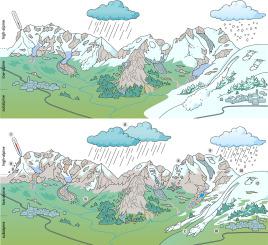Detecting the impact of climate change on alpine mass movements in observational records from the European Alps
IF 10.8
1区 地球科学
Q1 GEOSCIENCES, MULTIDISCIPLINARY
引用次数: 0
Abstract
Anthropogenic climate change is rapidly altering high mountain environments, including changing the frequency, dynamic behavior, location, and magnitude of alpine mass movements. Here, we review three decades of scientific literature (1995 to early 2024) to assess to what degree observational records from the European Alps – as the region with the most comprehensive records – reveal these changes. We do this for the processes that are most common in this region, namely rockfall, rock avalanches, debris flows, ice avalanches, and snow avalanches. The systematic literature search and review yielded 335 publications, of which we omitted publications that did not focus primarily on observational records. The remaining 103 publications used observations from over 100 sites and 30 inventories to investigate the connection between climate change and mass movements. About one third of the relevant studies found a measurable impact of climate change on the investigated alpine mass movement processes (with the exception of large rock avalanches). The clearest climate-controlled trends are (i) increased rockfall frequency in high-alpine areas due to higher temperatures, (ii) fewer and smaller snow avalanches due to scarcer snow conditions at low and mid elevations, and (iii) a shift towards avalanches with more wet snow and fewer powder clouds. While there is (iv) despite a clear increase in debris-flow triggering precipitation, debris-flow activity has not been found to uniformly increase, though there is some evidence for increasing activity above treeline and at locations without historical precedence. The trends for (v) ice avalanches are spatially very variable with no clear direction. Ice temperatures are measurably increasing, but – despite a theoretical expectation – this has not impacted ice avalanche activity to date. The reviewed literature also reveals that quantifying the impact of climate change on these mass movements remains difficult in part due to the complexities of the natural system, but also because of limitations in the available datasets, confounding effects, and existing statistical processing techniques. Better assessments could be achieved if we would more broadly support the compilation and maintenance of large standardized data catalogs, bring together various dispersed datasets (in said catalogs), including from social and citizen science projects, invest in long-term natural observatories, and develop suitable processing techniques. Better observations will additionally support the development and performance of process-based models. If we can advance natural hazard research on these fronts, more quantitative predictions of future change are well within our reach.

从欧洲阿尔卑斯山的观测记录中发现气候变化对阿尔卑斯山地块移动的影响
人为气候变化正在迅速改变高山环境,包括改变高山地块移动的频率、动态行为、位置和规模。在此,我们回顾了三十年来(1995 年至 2024 年初)的科学文献,以评估欧洲阿尔卑斯山(拥有最全面记录的地区)的观测记录在多大程度上揭示了这些变化。我们针对该地区最常见的过程,即落石、岩崩、泥石流、冰崩和雪崩进行了评估。通过系统的文献检索和审查,我们获得了 335 篇出版物,其中我们忽略了那些不以观测记录为主要重点的出版物。其余 103 篇文献利用 100 多个地点的观测数据和 30 份清单来研究气候变化与大规模移动之间的联系。约有三分之一的相关研究发现,气候变化对所调查的高山雪崩过程(大型岩崩除外)产生了可测量的影响。最明显的受气候控制的趋势是:(i) 由于气温升高,高山地区的落石频率增加;(ii) 由于中低海拔地区的积雪条件较差,雪崩的数量减少,规模缩小;(iii) 雪崩转向湿雪较多、粉云较少的情况。尽管(iv) 引发雪崩的泥石流降水明显增加,但泥石流活动并没有出现一致的增加,尽管有一些证据表明,在树线以上和没有历史先例的地点,泥石流活动有所增加。(v) 冰崩的趋势在空间上变化很大,没有明确的方向。冰层温度明显升高,但尽管理论上可以预期,但迄今为止这并未对冰崩活动产生影响。查阅的文献还显示,量化气候变化对这些大规模运动的影响仍然很困难,部分原因是自然系统的复杂性,但也因为现有数据集、混杂效应和现有统计处理技术的局限性。如果我们能更广泛地支持大型标准化数据目录的编制和维护,汇集各种分散的数据集(在上述目录中),包括来自社会和公民科学项目的数据集,投资于长期的自然观测站,并开发合适的处理技术,就能实现更好的评估。更好的观测还将为基于过程的模型的开发和性能提供支持。如果我们能在这些方面推进自然灾害研究,那么对未来变化进行更多量化预测就指日可待了。
本文章由计算机程序翻译,如有差异,请以英文原文为准。
求助全文
约1分钟内获得全文
求助全文
来源期刊

Earth-Science Reviews
地学-地球科学综合
CiteScore
21.70
自引率
5.80%
发文量
294
审稿时长
15.1 weeks
期刊介绍:
Covering a much wider field than the usual specialist journals, Earth Science Reviews publishes review articles dealing with all aspects of Earth Sciences, and is an important vehicle for allowing readers to see their particular interest related to the Earth Sciences as a whole.
 求助内容:
求助内容: 应助结果提醒方式:
应助结果提醒方式:


